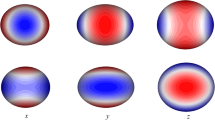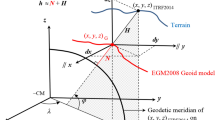Abstract
A general triaxial ellipsoid is suitable to represent the reference surface of the celestial bodies. The transformation from the Cartesian to geodetic coordinates on the triaxial ellipsoid becomes an important issue in geodesy. In the literature, the vector iterative method and the Newton’s iterative method for solving the nonlinear system of equations or an algebraic fraction equation is applied to compute the geodetic coordinates, but may lead to the non-convergence regions. In this work, the universal algorithm including the Newton’s iterative solutions of an algebraic sextic equation for the points outside the equatorial plane and the analytic solutions for the points inside the equatorial plane are used to compute the geodetic coordinates. The numerical experiments show the algorithm is fast, highly accurate and well convergent. The algorithm is valid at any point inside and outside the celestial bodies including the points near the celestial bodies’ center and in the singular elliptical disc.
Similar content being viewed by others
References
Abel N.H. and Galois É., 1889. Abhandlungen über die algebraische Auflösung der Gleichungen. Springer, Berlin, Germany (in German).
Bell R.J.T., 1923. An Elementary Treatise on Coordinate Geometry of Three Dimensions. MacMillan, London, U.K.
Borkowski K.M., 1987. Transformation of geocentric to geodetic coordinates without approximations. Astrophys. Space Sci., 139, 1–4.
Borkowski K.M., 1989. Accurate algorithms to transform geocentric to geodetic coordinates. Bull. Géod., 63, 50–56.
Bowring B.R., 1976. Transformation from spatial to geographical coordinates. Surv. Rev., 23, 323–327.
Burša M., Šima Z. and Pícha J., 1980. Tri-axiality of the Earth, the moon and mars. Stud. Geophys. Geod., 24, 211–217.
Eberly D., 2018. Distance from a Point to an Ellipse, an Ellipsoid, or a Hyperellipsoid (https://www.geometrictools.com/Documentation/DistancePointEllipseEllipsoid.pdf).
Feltens J., 2008. Vector methods to compute azimuth, elevation, ellipsoidal normal, and the cartesian (X, Y, Z) to geodetic (φ, λ, h) transformation. J. Geodesy, 82, 493–504.
Feltens J., 2009 Vector method to compute the cartesian (X, Y, Z) to geodetic (φ, λ, h) transformation on a triaxial ellipsoid. J. Geodesy, 83, 129–137.
Fukushima T., 1999 Fast transform from geocentric to geodetic coordinates. J. Geodesy, 73, 603–610.
Fukushima T., 2006. Transformation from cartesian to geodetic coordinates accelerated by Halley’s method. J. Geodesy, 79, 689–693.
Gonzalez-Vega L. and Polo-Blanco I., 2009. A symbolic analysis of Vermeille and Borkowski polynomials for transforming 3D cartesian to geodetic coordinates. J. Geodesy, 83, 1071–1081.
Hedgley D.R., 1976. An Exact Transformation from Geocentric to Geodetic Coordinates for Nonzero Altitudes. NASA Technical Rreport R-458, NASA Dryden Flight Research Center, Edwards, CA.
Heiskanen W.A. and Moritz H., 1967. Physical Geodesy. Freeman, San Francisco, CA.
Horner W.G., 1819. A new method of solving numerical equations of all orders, by continuous approximation. Philos. Trans. Roy. Soc. London., 109, 308–335.
Jenkins M.A. and Traub J.F., 1970. A three-stage variable-shift iteration for polynomial zeros and its relation to generalized Rayleigh iteration. Numer. Math., 14, 252–263.
Jones G., 2002. New solutions for the geodetic coordinate transformation. J. Geodesy, 76, 437–446.
Laskowski P., 1991. Is Newton’s iteration faster than simple iteration for transformation between geocentric and geodetic coordinates? Bull. Géod., 65, 14–17.
Ligas M., 2012a. Cartesian to geodetic coordinates conversion on a triaxial ellipsoid. J. Geodesy, 86, 249–256.
Ligas M., 2012b. Two modified algorithms to transform cartesian to geodetic coordinates on a triaxial ellipsoid. Stud. Geophys. Geod., 56, 993–1006.
Lin K.C. and Wang J., 1995. Transformation from geocentric to geodetic coordinates using Newton’s iteration. Bull. Géod, 69, 300–303.
Müeller B., 1991. Kartenprojektionen des dreiachsigen Ellipsoids. MSc Thesis. University Stuttgart, Stuttgart, Germany (https://www.gis.unistuttgart.de/lehre/abschlussarbeiten/MSc/MULL_1991_a.pdf, in German).
Pollard J., 2002. Iterative vector methods for computing geodetic latitude and height from rectangular coordinates. J. Geodesy, 76, 36–10.
Seidelmann P.K., Archinal B.A., A’Hearn M.F., Conrad A., Consolmagno G., Hestroffer D., Hilton J., Krasinsky G., Neumann G., Oberst J., Stooke P., Tedesco E.F., Tholen D.J., Thomas P.C. and Williams I.P., 2007. Report of the IAU/IAG working group on cartographic coordinates and rotational elements: 2006. Celest. Mech. Dyn. Astron., 98, 155–180.
Turner J.D., 2009. A non-iterative and non-singular perturbation solution for transforming cartesian to geodetic coordinates. J. Geodesy, 83, 139–145.
Vermeille H., 2002. Direct transformation from geocentric coordinates to geodetic coordinates. J. Geodesy, 76, 451–454.
Vermeille H., 2004. Computing geodetic coordinates from geocentric coordinates. J. Geodesy, 78, 94–95.
Vermeille H., 2011. An analytical method to transform geocentric into geodetic coordinates. J. Geodesy, 85, 105–117.
Zhang C., Hsu H., Wu X., Li S., Wang Q., Chai H. and Du L., 2005. An alternative algebraic algorithm to transform cartesian to geodetic coordinates. J. Geodesy, 79, 413–420.
Acknowledgements
This work is supported by National Natural Science Foundation of China under Grant Nos. 41631072 and 41774021.
Author information
Authors and Affiliations
Corresponding author
Rights and permissions
About this article
Cite this article
Chen, C., Bian, S. & Li, S. An optimized method to transform the Cartesian to geodetic coordinates on a triaxial ellipsoid. Stud Geophys Geod 63, 367–389 (2019). https://doi.org/10.1007/s11200-018-0589-1
Received:
Revised:
Accepted:
Published:
Issue Date:
DOI: https://doi.org/10.1007/s11200-018-0589-1




